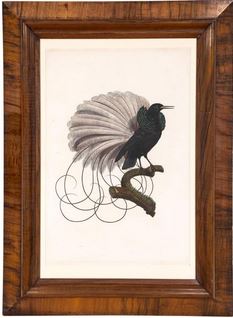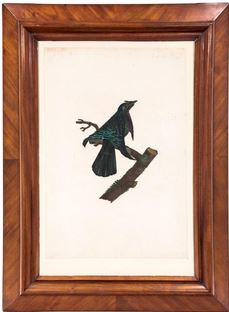 Loading... Please wait...
Loading... Please wait...All prices are in All prices are in AUD
Categories
- Home
- Blog History Revisited
- Birds of Paradise: "Birds of Perpetual Flight"?
Birds of Paradise: "Birds of Perpetual Flight"?
Posted by Sandra J. Ker, Antiquarian Print Gallery 1989-2016, Dealer Antique Prints & Maps, South Australia, www.historyrevisited.com.au on 30th Jul 2016
The Age of the Intrepid Explorer
The Age of Enlightenment gave rise to great explorers, both for new lands to expand Empires, to find new trading opportunities to finance empire-expansion, and extend the knowledge of science and the natural world. New discoveries needed artists to record them. Wealthy men of science became benefactors encouraging artists to scientifically render the botany and zoology rather than decorative stylized beauty. It was the need to establish lucrative trade routes that caused the first recorded circumnavigation of the world. It also brought back some most beautiful bird skins that revealed something never before known...
Legend of "Perpetual Flight" Begins
In 1519 Portuguese explorer, Ferdinand Magellan (1480 -1521) was commissioned to find an eastern trade route to the exotic wealth of the East Indies. This was the first recorded circumnavigation of the world. Now, being the first can be great, however not only did he die in his effort but in 1522 only 18 of the original 237 men returned.They did managed to bring back five exotic shimmering skins full of colorful feathers obtained in Malaka. They were meant as an example of potential trade goods in feathers, but ended up "stuffed" as a tribute to King Charles V of Spain. A perplexed "animal stuffer"(taxidermist) could find no evidence of LEGS on the skins (that knife must have been very sharp Indeed!). It is logical that for the purposes of long voyages in a tropical climate, the legs and viscera were removed in an effort to prevent the stench of rotting flesh & preserve such beauty. So it came to pass these colorful exotic birds, yet to be classified, became "birds of Perpetual Flight...mythical creatures that lived on the sun's nectar", in the absence of any scientific explanation for such a state of being.
Holland's Demand for Curiosity Cabinet Fodder
Of course, the feathers would find their way to a lucrative fashion market, but, equally, there was a high demand for such ornithological conundrums in any number of fashionable European Curiosity Cabinets. As early as 1596, the Dutch explorer, Jan Huygens van Linschoten already had an enthusiastic entry in his log book about the Bird of Paradise as demand was high. The Dutch East India Company no doubt exploited this cabinet display demand killing tens of thousands for their curiosity value alone, to the detriment of all Birds of Paradise...and all this before the feathers were prized adornment of ladies bonnets & military attire in the 1800s. Moral is, it does not pay to be so beautiful or majestic as once you are discovered your end is nigh!
Carl Linnaeus Sets Things Straight
It wasn’t until the famous Swedish naturalist, Carl Linnaeus (1707-1778) examined the preserved birds that he ended the idea of perpetual flight. His "biological binomial nomenclature system" put that idea to bed once and for all. He was also the originator of the name "Bird of Paradise".
.
Explorer François Levaillant (1753-1824)
A man of many skills, Levaillant was a naturalist, zoological collector, noted ornithologist and author. He was stoutly opposed to Linnaeus’ Latin classification protocol. He favored the use of of descriptive French names. It is for this reason that his spectacular exotic bird publication “Histoire naturelle des oiseaux de paradis ...” , published Paris 1801-1806, have names like “Le Nébuleux étalant ses parures”, or “The Nébuleux Spreading its trimmings” and “Le Superbe étalant ses parures”, or “The Superb spreading its trimmings” (both illustrated below). On his return from his numerous voyages, he sent over 2,000 bird skins to Jacob Temminck, who financed his expeditions. Temminck's son, Coenraad Jacob Temminck, studied them. They were later sent to the Lieden Museum collection and others were bought by the Rijksmuseum van Natuurlijke Historie in the 1820s. It is these mounted specimens that the renown artist Jacques Barraband paints in preparation for Levaillant's publication.

Artist Jacques Barraband (1767?-1809)

Zoological and botanical illustrator renowned for his life-like renderings of tropical birds. Jacques Barraband was commissioned personally by Napoleon Bonaparte to contribute his masterful art to this fabulous "grand folio sized book of exotic birds - to which absolutely nothing compares.” His paintings were based on mounted, taxidermed, specimens collected by Levaillant. (Note that our specimens from this series have their legs!) His illustrations were, and still are, considered the most accurate ones made during the early 1800s. His most famous works are those illustrating François Levaillant’s scientific ornithological studies, the "Histoire naturelle des Oiseaux de paradis et des Rolliers".These were among his last. It seems the engraver, Langlois, (also engraver to botanist Pierre-Joseph Reoubte), in turn, translated Barraband's exquisite exotic watercolours into hand colored copper engraving. The resplendent bird to the left (I call him Louie) I believe, is a Black Sicklebill. The tail feathers, in life, were straight, and the beak is curved. After leaving the humid equatorial forest home we can assume the feathers, no longer benefiting from its proud owner's preening, with that curved beak that has lost its curve. Having been skinned to prevent rotting in the warm moist air, these gorgeous feathers would have tightened in the cold drier air of Europe. This is evidenced by the elegant random curl we see in Barraband's portrait, bearing no resemblance to its live comparison. Oh, the ignominy of curiosity!
Recent Posts
- » Schomburgk's Botanic Garden & Park Plan, 1874
- » "City of Adelaide" Clipper Ship - What is Old Is New Again
- » Napoleon, Hudibrastic Poetry, Doctor Syntax & the Power of Satire
- » Colonial Melbourne to Albury "Parlour Car" Photo Connects to Adelaide Past & Present
- » May Gibbs: Successful Business Woman










